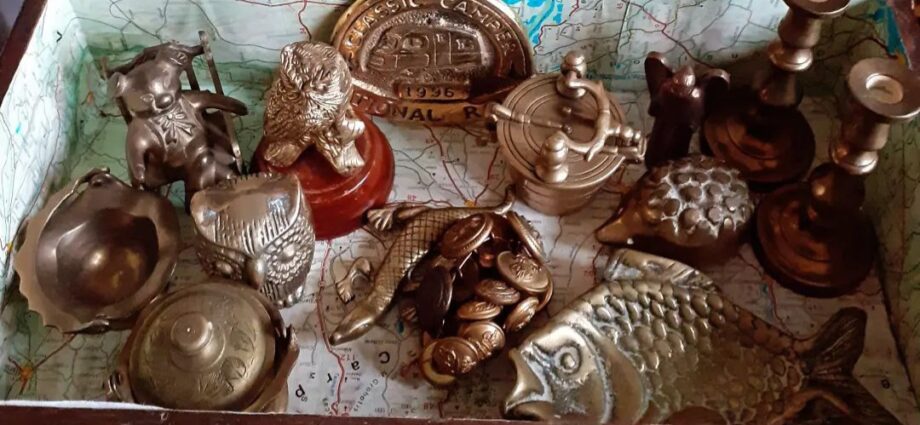Brass ornaments have a rich history spanning centuries, with their origins rooted in ancient craftsmanship. Brass, an alloy of copper and zinc, was first developed in the early 1st millennium BCE. Its bright golden hue and malleable yet durable nature made it a favoured material for decorative and utilitarian objects.
Ancient Civilizations: Early use of brass can be traced to Mesopotamia, Egypt, and the Indus Valley, where it was fashioned into jewellery, vessels, and religious artefacts. The Greeks and Romans later used brass for coins, statues, and ornamental weaponry, admiring its aesthetic appeal and corrosion resistance.
Medieval Europe: In medieval times, brass became central to church and domestic décor. Candlesticks, altar pieces, and ceremonial objects were common. Guilds in regions such as Germany and Flanders mastered the art, creating intricate designs that reflected the Gothic and Renaissance styles.
Industrial Revolution: The 18th and 19th centuries marked a turning point as mass production techniques made brass objects more affordable. During this period, brass ornaments such as clocks, lamps, and picture frames adorned the homes of the burgeoning middle class.
20th Century and Beyond: The modern era saw a revival of interest in brass during the Art Deco and Mid-Century Modern movements. Designers embraced brass for its clean lines and timeless elegance, producing pieces that remain iconic today.
The Decorative Evolution of Brass Home Objects
The decorative appeal of brass ornaments has been shaped by cultural, artistic, and technological influences over centuries.
Symbolism and Aesthetics: In ancient and medieval societies, brass was often associated with wealth, power, and religious significance. Many designs were inspired by natural motifs, such as leaves, flowers, and animals, reflecting humanity’s connection to nature.
Cultural Influences:
- Asian Aesthetics: In China and India, brass artefacts like incense burners and figurines were adorned with intricate carvings and symbolic motifs, often tied to religious practices.
- Islamic Art: Brass inlays with silver or copper became a hallmark of Islamic decorative arts, seen in bowls, ewers, and trays featuring geometric and calligraphic patterns.
- European Styles: In the Renaissance and Baroque periods, brass items featured elaborate scrollwork, cherubs, and mythological scenes.
Modern Design Trends: The 20th century introduced minimalist and geometric designs during the Art Deco movement, followed by organic and functional styles in the Mid-Century era. Brass home décor also became a staple of Hollywood Regency, lending a touch of glamor.
Techniques and Innovation: Techniques such as casting, embossing, engraving, and polishing have continually evolved. Modern methods allow for precision and mass production, yet handcrafted brass ornaments remain highly valued for their artistry.
The Collectability of Brass Ornaments Today
Brass ornaments have gained significant attention among collectors and interior design enthusiasts, thanks to their historical and aesthetic value.
Factors Influencing Collectability:
- Age and Rarity: Older pieces, especially those from specific periods or regions, are highly sought after. Antique brass from the Ming Dynasty or Victorian England can fetch high prices.
- Craftsmanship: Handcrafted items with detailed workmanship and intricate designs hold greater value.
- Condition and Patina: While some collectors prefer polished brass, others cherish the natural patina that develops over time, as it adds character and authenticity.
Popular Collectibles:
- Antique Items: Examples include candlesticks, clocks, door knockers, and musical instruments.
- Decorative Sculptures: Animals, mythical creatures, and abstract designs are particularly popular.
- Functional Artifacts: Items like trays, vases, and picture frames blend utility with artistic appeal.
Contemporary Market Trends:
- Brass has experienced a resurgence in home decor due to the popularity of vintage and eclectic design styles.
- Collectors value the mix of historical and modern brass items for their versatility in various interior themes.
Maintaining and Displaying Brass:
- Proper care, including gentle cleaning to avoid damage to finishes, is essential for preserving value.
- Display strategies, such as grouping similar items or using brass as a statement piece, highlight its elegance.
Investment Potential: With increasing interest in sustainable and timeless materials, brass ornaments are not only decorative but also a growing area of investment for collectors.
Wildcard Curiosities
Wildcard Curiosities
For more informative blogs, our shop and all about who we are. Keep searching our website and check us out on social media @wildcardcuriosities
